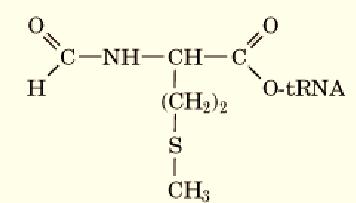


 النبات
النبات
 الحيوان
الحيوان
 الأحياء المجهرية
الأحياء المجهرية
 علم الأمراض
علم الأمراض
 التقانة الإحيائية
التقانة الإحيائية
 التقنية الحيوية المكروبية
التقنية الحيوية المكروبية
 التقنية الحياتية النانوية
التقنية الحياتية النانوية
 علم الأجنة
علم الأجنة
 الأحياء الجزيئي
الأحياء الجزيئي
 علم وظائف الأعضاء
علم وظائف الأعضاء
 الغدد
الغدد
 المضادات الحيوية
المضادات الحيوية|
Read More
Date: 12-5-2016
Date: 22-3-2021
Date: 3-6-2021
|
FMET (N-Formyl Methionine(
Protein biosynthesis usually starts with N-formyl methionine (Fig. 1), which is directed by the initiation codon AUG, or rarely in bacteria by GUG or UUG. The same triplet AUG is decoded as a normal methionine during elongation. These distinct types of recognition are carried out by distinct transfer RNAs, initiator tRNAfMet and elongator tRNAMet. The initiator tRNA carries a methionine residue that has been formylated on its amino group (N-formyl-methionyl-tRNAfMet, or fMet-tRNAfMet). Synthesis of fMet-tRNAfMet proceeds in two steps: (i) aminoacylation of the initiator tRNA with methionine and (ii) formyl transfer from formyltetrahydrofolate to the methionine amino group. The latter reaction is catalyzed by a formyltransferase.

Figure 1. fMet (N-formyl methionine).
Only fMet-tRNAfMet is used for initiation of protein synthesis, because it enters part of the P site on the prokaryotic 30S or eukaryotic 40S ribosome subunit (see Initiation Complex and Initiation Factor (IF)). Often the N-terminal formyl residue is removed by a specific deformylase enzyme. Sometimes the methionine residue at the terminus is removed by an aminopeptidase. These reactions occur rather rapidly, probably when the nascent polypeptide chain reaches the length of 15 to 30 amino acids.



|
|
|
|
دخلت غرفة فنسيت ماذا تريد من داخلها.. خبير يفسر الحالة
|
|
|
|
|
|
|
ثورة طبية.. ابتكار أصغر جهاز لتنظيم ضربات القلب في العالم
|
|
|
|
|
|
|
سماحة السيد الصافي يؤكد ضرورة تعريف المجتمعات بأهمية مبادئ أهل البيت (عليهم السلام) في إيجاد حلول للمشاكل الاجتماعية
|
|
|